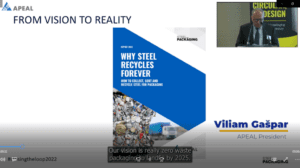The importance of second overband magnets in sorting plants
By Alexis Van Maercke
On 1st February during our conference From Vision to Reality; Closing the loop on steel packaging, we launched our new report How to recycle steel – Why steel packaging recycles forever.
The fourth of our six key recommendations in this report is to introduce second overband in sorting plants. For whilst an average of 84% of all steel packaging is currently recycled across Europe, the collection and sorting of steel caps, ends and closures is estimated to be below-average.
 This is due to a combination of low awareness among citizens and inadequate sorting facilities. Indeed, better capturing closures was one of the many subjects evoked by panelists of our conference’s second panel on optimising separate collection, which featured Joachim Quoden, Managing Director of EXPRA, Clarissa Morawski, CEO and co-founder of the Reloop Platform and Tim Moerman, Sustainability & ESG Director Europe, Anhauser-Busch Inbev (ABInBev).
This is due to a combination of low awareness among citizens and inadequate sorting facilities. Indeed, better capturing closures was one of the many subjects evoked by panelists of our conference’s second panel on optimising separate collection, which featured Joachim Quoden, Managing Director of EXPRA, Clarissa Morawski, CEO and co-founder of the Reloop Platform and Tim Moerman, Sustainability & ESG Director Europe, Anhauser-Busch Inbev (ABInBev).
Watch more in our highlights video here.
 When collected together with other recyclable waste fractions, steel packaging can easily be separated using an overband magnetic separator at the sorting plant. However, in many plants, the sorting process starts with a rotating trommel with holes to separate the waste packaging flows by size. This means that smaller steel items, such as ring-pulls and closures, are at risk of not being separated for recycling and can therefore be lost.
When collected together with other recyclable waste fractions, steel packaging can easily be separated using an overband magnetic separator at the sorting plant. However, in many plants, the sorting process starts with a rotating trommel with holes to separate the waste packaging flows by size. This means that smaller steel items, such as ring-pulls and closures, are at risk of not being separated for recycling and can therefore be lost.
APEAL therefore recommends that sorting plants install a second overband to capture these small steel items. This would improve recycling rates as more steel would be recovered prior to the recycling process. To support the installation of additional magnets, authorities could offer grants or other incentives to sorting facilities in order to keep valuable resources in the circular loop.
However, even when installing an additional overband magnet, it cannot be guaranteed that the steel packaging scrap bundle does not contain impurities. Ultimately, if we are to reach APEAL’s vision of zero steel packaging to landfill by 2025, we believe that optimised separate collection is the key to high quality recycling.
 A copy of the report can be downloaded here
A copy of the report can be downloaded here
